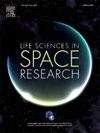The effect of Hydrogen-rich water on retinal degeneration in the outer nuclear layer of simulated weightlessness rats
IF 2.8
3区 生物学
Q2 ASTRONOMY & ASTROPHYSICS
引用次数: 0
Abstract
Long-term spaceflight can lead to changes in eye structure and decreased visual function. At present, there are almost no effective methods to prevent and treat eye damage caused by microgravity environments. Oxidative stress has been identified as one of the contributing mechanisms of spaceflight-associated neuro-ocular syndrome (SANS), and hydrogen (H2) has demonstrated significant antioxidant and anti-inflammatory effects. The aim of this study was to determine whether hydrogen-rich water (HRW) has a protective effect against eye injury induced by tail-suspension simulated weightlessness in rats, and to elucidate the underlying mechanisms. In this experiment, we utilized an 8-week tail-suspension model to simulate weightlessness, and employed histopathology, visual electrophysiology, and biochemical indices to evaluate retinal structure, function, and related molecular mechanisms leading to retinal damage. We also assessed the therapeutic efficacy of HRW treatment. Results demonstrated that tail-suspension simulated weightlessness induced thinning of the retinal outer nuclear layer, decreased visual function, and promoted retinal inflammation, oxidative stress, and mitochondrial dysfunction in rats. HRW treatment effectively alleviated the degenerative changes in the retinal outer nuclear layer, improved retinal function, and reduced retinal inflammation in treated rats. Our findings revealed that HRW reduced the retinal oxidative stress response and enhanced mitochondrial function through the PI3K/Akt/Nrf2 signaling pathway. Overall, HRW may be a promising candidate for the treatment of eye injuries in simulated microgravity environments.
富氢水对模拟失重大鼠核外层视网膜退化的影响
长期太空飞行会导致眼睛结构发生变化和视觉功能下降。目前,几乎还没有有效的方法来预防和治疗微重力环境对眼睛造成的损伤。氧化应激已被确定为导致太空飞行相关神经眼综合征(SANS)的机制之一,而氢气(H2)已被证明具有显著的抗氧化和抗炎作用。本研究旨在确定富氢水(HRW)是否对大鼠因尾部悬空模拟失重引起的眼损伤具有保护作用,并阐明其潜在机制。在本实验中,我们利用为期 8 周的尾部悬吊模型模拟失重状态,并采用组织病理学、视觉电生理学和生化指标来评估视网膜结构、功能和导致视网膜损伤的相关分子机制。我们还评估了HRW治疗的疗效。结果表明,尾悬浮模拟失重诱导大鼠视网膜核外层变薄、视功能下降,并促进视网膜炎症、氧化应激和线粒体功能障碍。HRW治疗可有效缓解大鼠视网膜核外层的退行性变化,改善视网膜功能,减少视网膜炎症。我们的研究结果表明,HRW可通过PI3K/Akt/Nrf2信号通路降低视网膜氧化应激反应,增强线粒体功能。总之,HRW可能是在模拟微重力环境中治疗眼损伤的一种有前途的候选药物。
本文章由计算机程序翻译,如有差异,请以英文原文为准。
求助全文
约1分钟内获得全文
求助全文
来源期刊

Life Sciences in Space Research
Agricultural and Biological Sciences-Agricultural and Biological Sciences (miscellaneous)
CiteScore
5.30
自引率
8.00%
发文量
69
期刊介绍:
Life Sciences in Space Research publishes high quality original research and review articles in areas previously covered by the Life Sciences section of COSPAR''s other society journal Advances in Space Research.
Life Sciences in Space Research features an editorial team of top scientists in the space radiation field and guarantees a fast turnaround time from submission to editorial decision.
 求助内容:
求助内容: 应助结果提醒方式:
应助结果提醒方式:


